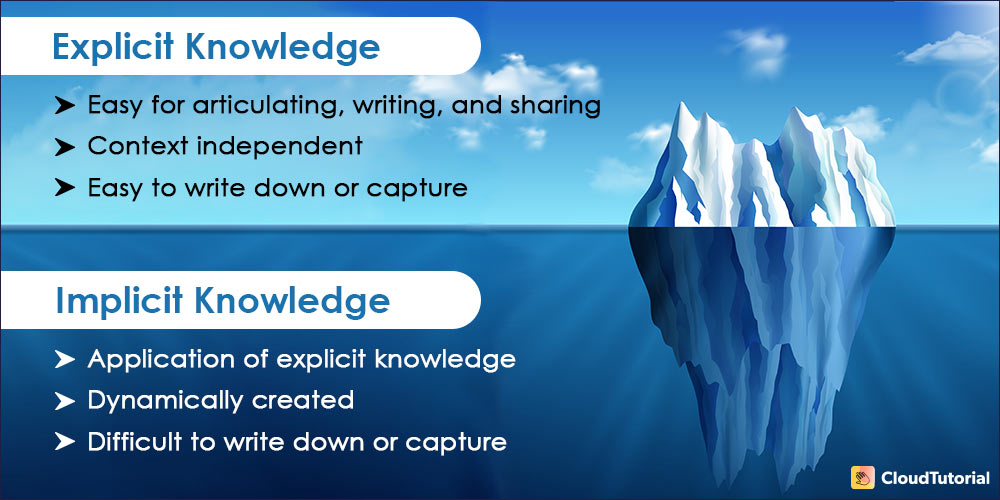Knowledge management is about creating and maintaining a repository of information and data that is useful for your customers as well as your workers.
While a lot of this knowledge is readily available to us, there’s a large chunk of it that is not served on a silver platter. This is why it is so important to understand the types of knowledge available, how to record them, and use them to the best of our abilities for making positive changes in the organization.
In order to really grasp the different types of knowledge available to you and develop a knowledge sharing strategy for your organization, you need to first understand the different types of knowledges:
- Explicit;
- Implicit; &
- Tacit.
This blog covers in-depth working on explicit knowledge and how it is different from other types of knowledge.
Table of Content
What is Explicit Knowledge?

Knowledge usually has different forms, depending on the business type. Let us understand what is explicit knowledge in this section.
The knowledge that can get easily articulated, codified, stored, and accessed is Explicit Knowledge. It is also known as expressive knowledge.
Such knowledge can be smoothly transmitted to other customers or employees and stored efficiently in certain media. For example, explicit knowledge is tangible, robust, and recorded in multiple documents and databases. Human skills and knowledge when externalized are turned into explicit knowledge.
Consider the market research report scenario. It includes essential information like recent trends, project definitions, necessary documents, customer roles & behaviors, analytic reports, and additional analysis and research reports. Explicit knowledge examples are documented work, procedures, and policies. Explicit knowledge can also be in the form of audio visual files.
What benefits does the organization grab by capturing and transferring explicit knowledge?
- Enhances decision-making capabilities
- Minimizing the duplication efforts
- Security against knowledge loss
- Creating robust processes and operations
The process of creating, circulating, and adapting different types of knowledge in new technologies, products, processes, or policies builds and defines the knowledge creating company.
The pattern that exists in the knowledge creating company is as follows:
- Absorb tacit knowledge like secrets and discussions through socialization.
- Translate absorbed tacit knowledge into explicit knowledge for further sharing with other members.
- The explicit knowledge is further standardized and recorded properly in the form of manuals, documents, or audio visual material.
- Apply this explicit knowledge to new products. It helps enrich and strengthen tacit knowledge of the organization.

Want to create knowledge base for your business?
CloudTutorial is the perfect tool for you. Create Your knowledge base without any chatbot and live chat.
What are Some of the Examples of Explicit Knowledge?
Explicit knowledge exists in our real-life scenario as it comes in encyclopedias and textbooks. Such knowledge comes in various forms like procedure manuals, documents, contents, procedures, audio-visuals, how-to videos, and other things that make an effective knowledge management system.
Engineering works and product design are examples of explicit knowledge that works entirely based on human skills, customers’ motivations, and external expertise.
Some of the best examples of explicit knowledge are as below:
- A sales team with a knowledge-sharing platform:
The collective human skills and knowledge encompassed within your sales workforce is extremely effective. And to sufficiently capture it, you must inspire every team member to participate in the knowledge-creating company. - Formal customer suggestions and complaints:
Customer suggestions and complaints must be processed, structured, and organized. Such explicit knowledge can be easily recorded, articulated, communicated, and most crucially stored to rectify the processes for gaining a great customer experience. It also helps executives understand how to handle customer queries. - Documented context work:
First, you need to determine which fields of your company need documentation. Then such documented context work can be used for relevance and validity. Also, you may cut off any outdated documents or information that are not helpful. It helps you keep the documents and the workers in the company up-to-date with all the relevant and new information. - Application or project definitions:
After jotting down all the details regarding your project or application, you can probably have a better idea about where the gaps are. Also, you can assign tasks to the relevant users within your departments with much precision. - Content creation policy:
You must view your content creation policy as a dynamic resource as it evolves as diverse employees impact its structure and development. And this is why forming such a content framework is vital to make sure that consistency is maintained as your business knowledge intensifies. - Job operating process:
By using a KM solution, you can easily organize and navigate your job operating process. Preferably, you must set up diverse categories, teams, and their projects so that no one gets clogged with inappropriate information. - Code of conduct for the organization:
Documenting a code of conduct will allow you to harness complete discipline followed organization-wide. It entails the ongoing commitment from employees, the usage of a reliable type of knowledge management system, and the right strategy. It is a great example of procedure management.stem, and the right strategy.
What is the Opposite of Explicit Knowledge?
Tacit knowledge works precisely opposite to explicit. The knowledge that humans use like personal experience and jobs is implicit.
Learning and expertise usually come from people’s minds—intelligence and experience, more challenging to extract and codify.
‘Tacit and implicit knowledge’ are the same words used by the organization. ‘Implicit’ is a type of knowledge that is usually implied in a statement but is not explicitly said. The term could refer to ideas that are connected with it in socially understandable manners.
Implicit knowledge has more complexities in transferring information in a written format like documents or through verbal methods.
A piece of explicit knowledge can be easily written down and understood by a reader. In contrast, riding a bicycle, playing a musical instrument, walking, speaking ability, and others that do not require any specific documentation are implicit knowledge.
Difference Between Explicit and Implicit Knowledge
| Explicit Knowledge | Implicit Knowledge |
|---|---|
| Easy for articulating, writing, and sharing | Implicit knowledge is the practical application of explicit knowledge | Explicit knowledge is the most basic form of knowledge | Implicit Knowledge is gained without any awareness that learning is occurring | Explicit knowledge is the most basic form of knowledge | Implicit Knowledge is gained without any awareness that learning is occurring |
| Best example: knowledge management platform | Best example: individuals following best practices and skills to perform their jobs |
| Externalized | Internalized |
| Context independent | Dynamically created |
| Explicit – Easy to write down or capture | Implicit – Difficult to write down or capture |
In simple words, we can say that tacit knowledge is explicit knowledge that has not gotten documented yet.
For codification purposes, explicit can be easily codified, just like writing code or performing word expressions. At the same time, implicit is not easy to understand, so there exists no chance to communicate, interpret, or use such information.
Such information is easily transferable as one needs to know a particular topic to transfer the knowledge. On the other hand, tacit knowledge does not support knowledge-sharing. It cannot get transferred from one person to another irrespective of the specific information that exists in the organization.

How does the transfer effectively take place to gain a competitive advantage?
- Face-to-face customer interactions
- Apprenticeship
- Mutual trust between the two
To know more about the best knowledge-sharing methods, we suggest checking out CloudTutorial’s blog on top knowledge-sharing methods for further reading.
Moreover, using logical deduction and practical experience, the company can quickly gain explicit knowledge. In implicit knowledge, an individual must have an expert company knowledge of a specific area. It gets acquired using in-depth analysis, research, and user experience.
The company can smoothly record such information and store it in physical formats like books, manuals, pdf, files, and other readable formats. The tacit knowledge is fast and presumed.
It is usually separated, whose collection process is quite complicated. So, perfect participation and cooperation are a must need for enhancing business performance.
To compare tacit and explicit knowledge, it is essential that you first understand how tacit and explicit knowledge take advantage of each other.
Implementing this new tacit and explicit knowledge typically starts on a personal basis. An intuitive sense of market trends usually helps the manager to create valuable new products.
How to Transfer Knowledge From One Form to Another
Tacit-to-Tacit
This knowledge sharing involves transferring Tacit Knowledge to an individual or group that retains it as Tacit.
When knowledge communities meet, and the common interests get together, they informally exchange information quickly.
Ex: Telephonic conversation, public meetings, group discussions, opinion polls, etc.
Tacit-to-Explicit
When an individual converts Tacit-to-Explicit, it gets referred to as Externalization. In simple words, it means that it makes internal & implicit knowledge as external & explicit knowledge.
Such conversion is possible just by formally codifying and expressing such knowledge in terminologies associated with Explicit.
Ex: Annual reports, rating & reviews, technical reviews, journals, and articles.
Explicit-to-Tacit
It is also known by the name “internalization” and takes place through learning and training. Explicitly creates a new Tacit Knowledge.
Ex: Reading articles, watching television, learning through textbooks, etc.
Explicit-to-Explicit
The process of creating new knowledge from the existing one is Explicit-to-Explicit. It usually works by integrating the information using statistical techniques and pattern detection.
Information that resides in media such as meetings, telephonic conversations, and networks is combined and exchanged through this process.
Ex: Digitized forms of documents and textbooks, software applications and tools, etc.

Share Your Organizational Knowledge Effectively.
With CloudTutorial you can organize all your valuable information in categories and sub categories.
The four knowledge types according to Krathwohl are:
- Factual: It allows exposure, repetition, and commitment to memory for the organizations.
- Conceptual: It deals with the facts that can get organized in a meaningful manner for your business growth.
- Procedural: It follows the basic principle of subject-specific skills, techniques, and methods to implement the knowledge.
- Metacognitive: It deals explicitly with strategic knowledge, contextual knowledge, and even self-knowledge.
There is a long list of examples of how you can express tacit knowledge. Some of the best ones are:
- Facial recognition
- Notion of language
- Content
- Document flow
- Bessemer steel process
Usually, there are three most common ways that organizations use such knowledge to transfer and retain. They are:
- Documentation
- Interviews
- Debriefings
Each section includes detailed implications for action when applying these solutions for knowledge transfer and retention and makes reliable use of the knowledge management system.
With the right strategy in place, the challenge of documenting and optimizing your company’s knowledge base can be made easy. All the knowledge in your organization has the ability to create the basis for success and excellence. You must not let it go to waste.
Using a reliable knowledge management system like CloudTutorial, the organization will be able to exploit the complete wisdom of their knowledge base.
Visit our website and schedule a demo today!
Try it out before you decide.
Create a test article NOW!
Using this tool, all you have to do is add your first test article and see how it looks. Now, you don’t have to sign-up or login into CloudTutorial software just to check how your first article appears.

